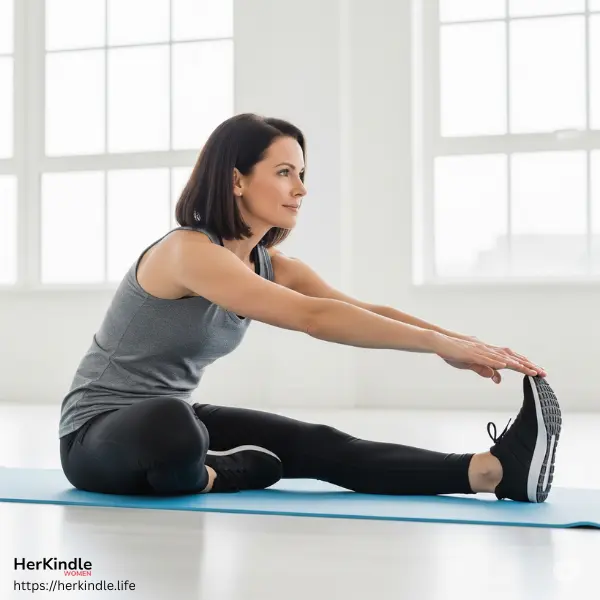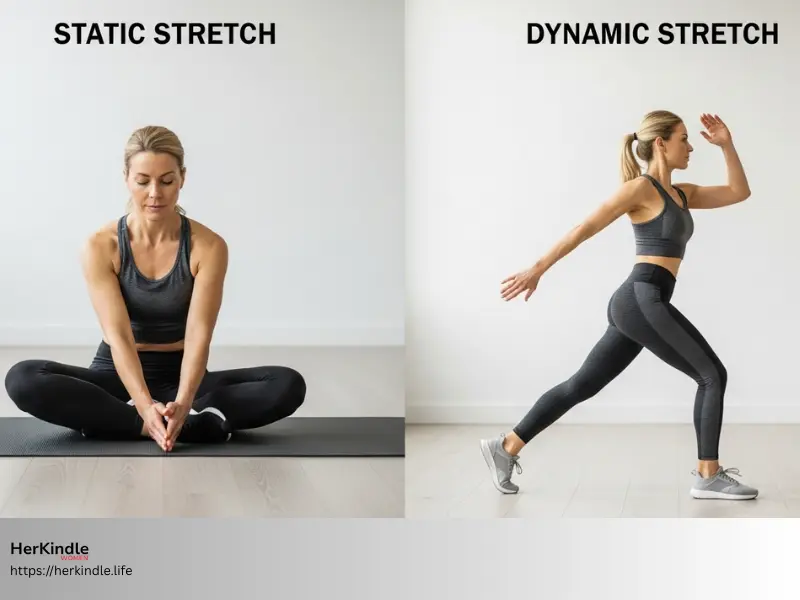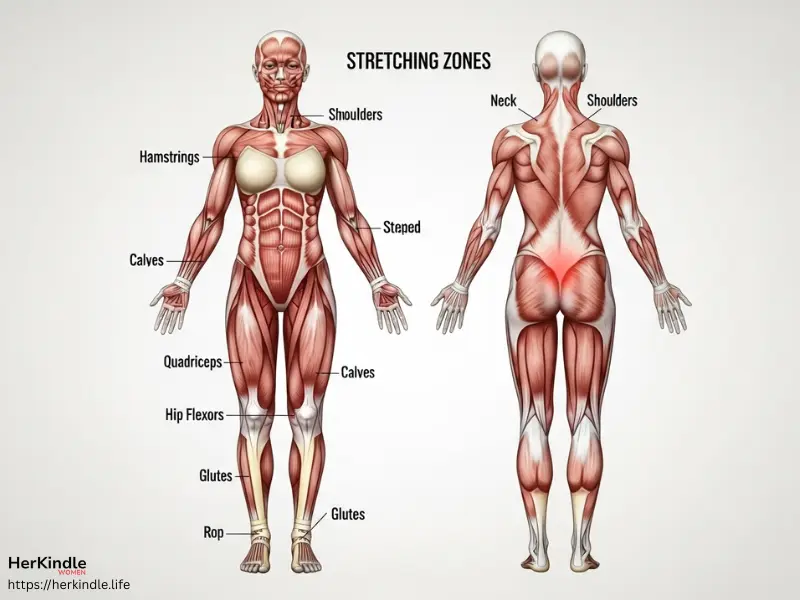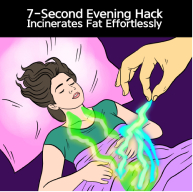Let’s be honest—life after 35 comes with its own set of physical surprises. For many women, stiffness, joint aches, or reduced range of motion aren’t rare occurrences—they’re a daily battle. But what if a consistent and well-designed stretching practice could not only relieve those issues but also reignite your physical confidence?
Stretching exercises aren’t just warm-ups or cool-downs anymore. Backed by years of research, stretching has evolved into a cornerstone of flexibility training, injury prevention, and holistic well-being.
In this guide, we’ll uncover:
- The scientific benefits of stretching
- Different types of stretching and when to use them
- How to stretch safely and effectively
- A complete guide to stretching for injury prevention
- Expert-approved stretching protocols for long-term flexibility
Whether you’re a fitness enthusiast or someone just starting your wellness journey, this guide will equip you with everything you need to unlock your peak flexibility and live life with ease and energy.
The Hidden Science Behind Stretching and Flexibility
Why Does Flexibility Matter More As You Age?
As we grow older, muscle fibers naturally lose elasticity, joints lose fluid, and tendons become stiffer. These physiological changes not only reduce mobility but can increase the risk of falls and injuries.
Regular stretching exercises counteract this decline by:
- Improving muscle extensibility
- Increasing joint range of motion (ROM)
- Enhancing neuromuscular coordination
How Stretching Works: Neurological & Structural Adaptation
Static stretching, the most studied method, works through two major mechanisms:
- Neurological Adaptation: Stretching desensitizes muscle spindles, allowing muscles to tolerate longer elongation.
- Structural Remodeling: It increases sarcomere (muscle fiber) length and connective tissue elasticity.
Together, these adaptations contribute to lasting flexibility improvements when stretching is done consistently over time.
9 Proven Benefits of Stretching You Shouldn’t Ignore
1. Enhances Flexibility
Consistent stretching increases the length and elasticity of muscles and connective tissues—essential for better movement.
2. Expands Range of Motion
You’ll notice smoother, fuller movements whether you’re reaching overhead, bending down, or twisting sideways.
3. Improves Muscle Function
Stretched muscles contract more efficiently, enhancing strength and performance in both workouts and daily life.
4. Reduces Injury Risk
Flexible muscles absorb more force, reducing the chance of muscle strains and joint injuries during physical activity.
5. Promotes Better Posture
Stretching corrects muscle imbalances that pull your posture out of alignment—especially helpful if you sit for long hours.
6. Boosts Circulation
Stretching increases blood flow to muscles, improving nutrient delivery and speeding up recovery after workouts.
7. Relieves Stress & Tension
Tight muscles often hold emotional stress. Stretching promotes deep relaxation through slow breathing and mindful movement.
8. Alleviates Chronic Pain
Conditions like arthritis or lower back pain often improve with consistent stretching by reducing tension and improving movement patterns.
9. Improves Athletic Performance
Increased flexibility enhances biomechanical efficiency, meaning you move better, faster, and stronger.
Types of Stretching Techniques and When to Use Them
Understanding types of stretching is essential to tailor your practice. Here’s a breakdown of the 7 most recognized techniques:
1. Static Stretching
- What it is: Holding a stretch position without movement (10–30 seconds)
- Best for: Post-exercise recovery, flexibility sessions
- Example: Seated hamstring stretch

2. Dynamic Stretching
- What it is: Controlled movements through full range of motion
- Best for: Warm-ups before exercise or sports
- Example: Leg swings, arm circles

3. Ballistic Stretching
- What it is: Bouncing movements beyond natural ROM
- Use with caution: Higher injury risk; suitable for trained athletes only
4. Active Stretching
- What it is: Holding a position using only your muscles
- Best for: Building strength and flexibility
- Example: Holding your leg up without assistance
5. Passive Stretching
- What it is: Holding a stretch with external assistance (partner or props)
- Best for: Deep tissue release, rehab routines
6. Isometric Stretching
- What it is: Contracting the muscle during a stretch
- Best for: Improving static-active flexibility
- Note: Requires professional guidance
7. PNF (Proprioceptive Neuromuscular Facilitation)
- What it is: Combines contraction and relaxation phases
- Best for: Rehab or athletic flexibility training
- Note: Extremely effective but should be performed under supervision
Stretching for Injury Prevention: What the Research Says
Does Stretching Prevent Injuries?
This topic is nuanced. While stretching alone doesn’t guarantee injury prevention, it plays a supportive role when combined with:
- Proper warm-ups
- Strength training
- Mobility work
Dynamic stretching is best used before workouts to reduce acute injury risk, while static stretching shines in cool-downs or flexibility sessions.
In Rehabilitation
Stretching is foundational in injury recovery, especially for conditions like hamstring strains. It helps:
- Realign collagen fibers
- Restore tissue length
- Improve range of motion
How to Build an Effective Stretching Routine (Backed by Science)
Frequency & Duration Guidelines
| Parameter | Recommendation |
|---|---|
| Frequency | At least 5x per week per muscle group |
| Duration per stretch | 30 seconds (static) |
| Sets per session | 2–4 sets |
| Total weekly time | 5 minutes per muscle group |
Tip: You can split the total into short sessions throughout the day.
When Should You Stretch?
| Timing | Stretching Type | Purpose |
|---|---|---|
| Pre-workout | Dynamic stretching | Prepare muscles for activity |
| Post-workout | Static stretching | Enhance flexibility and recovery |
| Morning/evening | Passive or PNF | Relaxation, deep stretch, injury rehab |
Sample Full-Body Stretching Routine (Beginner-Friendly)
This simple routine targets all major muscle groups and can be done in 15 minutes.

1. Neck Circles (Dynamic)
- Roll neck gently in circles, both directions – 20 sec each
2. Shoulder Stretch (Static)
- Pull one arm across your chest and hold – 30 sec each side
3. Chest Opener (Passive)
- Use doorway to stretch chest – 30 sec
4. Seated Hamstring Stretch (Static)
- Sit and reach toward toes – 30 sec each leg
5. Standing Quadriceps Stretch (Passive)
- Pull heel toward buttocks – 30 sec each leg
6. Calf Stretch (Static)
- Lean forward against wall – 30 sec per leg
7. Glute Stretch (Supine Figure 4)
- Lying down, cross one ankle over the knee – 30 sec each leg
Tip: Focus on slow breathing and stretch only to mild discomfort, not pain.
Stretching Tips for Women Over 35
Women over 35 face unique challenges—hormonal changes, sedentary work, and past injuries. Here’s how to adapt:
- Prioritize consistency over intensity
- Add balance exercises to improve coordination
- Stretch after warm showers to maximize muscle pliability
- Include mindful breathing to reduce tension and cortisol
Stretching isn’t just a routine—it’s self-care. Make it part of your daily ritual.
Frequently Asked Questions (FAQs)
Static stretching is a great place to start. It’s safe, effective, and easy to perform without assistance.
Yes! As long as you’re not overstretching, daily stretching supports long-term flexibility and injury prevention.
Absolutely. Stretching hip flexors, glutes, and hamstrings reduces strain on the lower back and improves spinal alignment.
Improvements in flexibility can begin within 2–4 weeks of consistent stretching, but long-term gains appear after 8–12 weeks.
Before exercise: Use dynamic stretches to warm up.
After exercise: Use static stretches to cool down and improve flexibility.
Flexibility Is Freedom
Stretching isn’t just a warm-up—it’s a lifelong investment in your body. Whether you’re lifting groceries, playing tennis, or dancing at your granddaughter’s wedding, flexibility keeps you moving confidently and pain-free.
Start where you are. Stretch gently. Stay consistent.
Over time, these small movements can create profound shifts in how you feel, move, and live.







